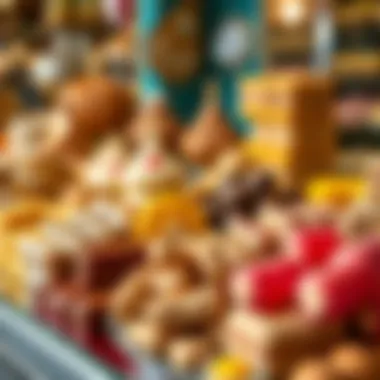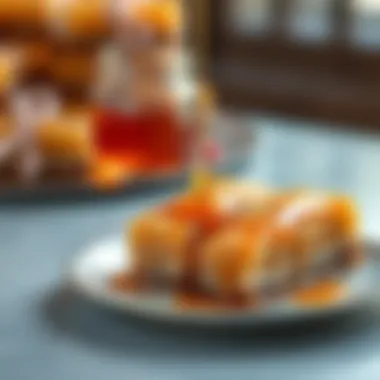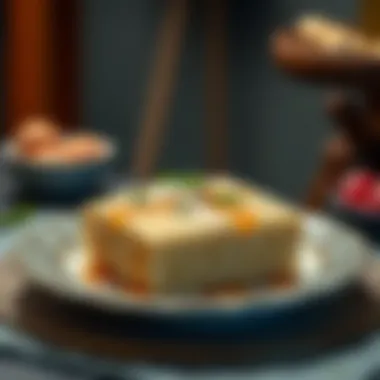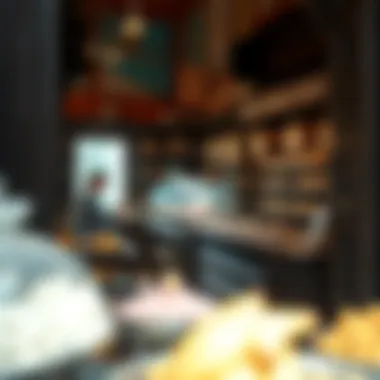Discovering Arabic Sweets in Dubai: A Taste Adventure


Intro
In the bustling streets of Dubai, a tapestry of scents and flavors beckons. Arabic sweets are not just desserts; they are a testament to the region's rich history and cultural significance. Each bite tells a story steeped in tradition, mixing flavors and textures that have been refined over centuries.
As expatriates and travelers meander through the vibrant markets, the lure of delicacies like Baklava, with its flaky layers of pastry and sweet syrup, or the creamy, warm goodness of Kunafa, sets the stage for a culinary journey unlike any other. The art of crafting these treats involves a delicate balance of ingredients— nuts, honey, and spices— each adding to a sweet narrative that has evolved alongside the city itself.
With cafes and bakeries springing up across the emirate, these confections have become more accessible than ever, promising both familiar comforts and playful innovations. From traditional family recipes passed down through generations to avant-garde twists in trendy eateries, the world of Arabic sweets in Dubai is dynamic and ever-changing.
This article will explore the various aspects of Arabic sweets available in Dubai, delve into their significance, and reveal the must-visit spots for both newcomers and seasoned sweet-tooths. With thoughtfully curated insights, our journey aims to guide you deeper into the heart of Emirati culinary traditions.
Foreword to Arabic Sweets
Arabic sweets stand as a testament to the rich culinary traditions that flourish in the Middle East, and Dubai, with its blend of cultures and vibrant lifestyle, is the ideal backdrop for experiencing this delightful segment of gastronomy. In this article, we explore various aspects of Arabic sweets, including their historical roots, cultural significance, and the myriad flavors that define them. For expatriates and visitors alike, understanding these confections not only enhances the appreciation of local culture but also elevates the overall experience of living or traveling in Dubai.
These sugary delights are more than just desserts; they embody centuries of tradition and craftsmanship. The importance of Arabic sweets stretches beyond just taste; they serve as social connectors, symbols of generosity, and protagonists in countless celebrations. For instance, baklava, with its intricate layers and honey-soaked perfection, often graces tables during festive occasions, highlighting its place in the hearts and homes of Emiratis.
On this culinary journey, readers will discover how Arabic sweets reflect a rich tapestry woven together by diverse ingredients and techniques. With choices ranging from the glossy, syrupy layers of kunafa to the compact sweetness of ma'amoul filled with dates, each bite tells a story of cultural heritage and communal bonding.
Moreover, the importance of these sweets in hospitality cannot be overlooked. Serving sweets to guests is not merely a tradition but also a gesture that conveys warmth and welcome—a cornerstone of Emirati culture that adds a personal touch to gatherings.
In summarizing the allure of Arabic sweets, one must consider their role not just as snacks, but as elements that weave together memories, celebrations, and shared experiences. This article invites you to dig deeper into the enchanting world of Arabic sweets in Dubai, celebrating the factors that make them an indispensable part of life in this dynamic city.
Historical Context of Arabic Sweets
Understanding the historical context of Arabic sweets is pivotal to appreciating their place in Emirati culture and the culinary landscape of Dubai. These delightful confections are not merely desserts; they are deeply woven into the fabric of social gatherings, celebrations, and daily life. Their journey reflects the rich heritage and evolving tastes of the region, serving as a marker of cultural exchange over centuries. The importance of this section lies in recognizing how these sweets have been shaped by historical events, trade routes, and cultural influences, enriching the culinary narratives of both the local populace and visiting expatriates.
Ancient Origins
The origins of Arabic sweets can be traced back to ancient civilizations where the fundamentals of pastry-making were birthed. Some historians argue that these sweets find roots in the Middle Eastern empires, such as the Umayyad and Abbasid dynasties, where innovative cooking techniques flourished. Ingredients like honey, nuts, and dried fruits were readily available and began to feature prominently in sweet dishes. Notably, sugar, which was introduced to the region through trade routes connecting the East and West, revolutionized these early confections.
This heritage can still be felt in the sweets enjoyed today, each bite echoing stories of ancient gatherings. For instance, the honey-soaked Baklava, beloved across the region, is a testament to the art of layering flavors and textures that has evolved from these centuries-old recipes.
Evolution Over Time
As trade expanded and cultures intermingled, Arabic sweets underwent significant evolution. The culinary traditions of the Middle East absorbed influences from Persian, Indian, and Mediterranean cuisines, leading to a diversification of flavors and techniques. This convergence enriched the repertoire of sweets, ensuring that they not only retained their traditional roots but also embraced modernity.
Furthermore, the advent of sugar refinement in the 16th and 17th centuries allowed chefs to explore new dimensions in sweetness. With the opening of Dubai's bustling markets and the increase in trade, local sweets began to adapt and evolve, creating unique Emirati variations. Today, we find popular treats like Knafeh and Ma'amoul that showcase a blend of ancient techniques with contemporary flair.
"Arabic sweets tell a story that travels through time, reflecting a rich tapestry of culture, trade, and innovation."
As we trace this evolution, it’s essential to highlight not only the transformation of recipes but also how these sweets have become social and ceremonial staples, bridging generations and fostering communal ties in Dubai. Emphasizing their historical context provides a deeper understanding of their existence today, revealing the allure behind every indulgent bite.
Cultural Significance
Arabic sweets hold a prominent place within the cultural fabric of Dubai, symbolizing the region's rich heritage and communal values. This section explores how sweets are more than just delightful treats; they embody customs, traditions, and a sense of belonging. The act of sharing these confections speaks volumes of hospitality, generosity, and connection among families and communities.
One cannot discuss Arabic sweets without mentioning their central role in Emirati traditions. From Eid celebrations to weddings, these delicacies enhance the festive atmosphere, reinforcing social bonds. When guests arrive, it is customary for hosts to offer sweets, showcasing their hospitality and welcoming spirit. This ritual transcends mere dining; it invites conversation, laughter, and the exchange of stories, linking individuals across generations.
Sweets in Emirati Traditions


In Emirati traditions, sweets often serve as more than just a finale to a meal; they are a part of the storytelling experience. Take Baklava, for example. This layered pastry rich with nuts and syrup is not only a feast for the palate but also signifies the melding of cultures throughout history. The sweetness of Baklava represents prosperity and good fortune. It is served both for celebrations and during family visits, bridging gaps among relatives and neighbors.
Furthermore, many sweets incorporate local flavors, like rosewater and cardamom, which connect the taste of the past with present generations. When a child celebrates their aqiqah, a traditional naming ceremony, it is common for families to prepare large platters of sweets, emphasizing the joy of family and community in their lives. Each bite tells a story, a reminder of who they are connected to and where they come from.
Celebrations and Occasions
Certain occasions in Dubai would feel incomplete without Arabic sweets taking center stage. Festivals like Ramadan and Eid showcase a plethora of desserts that reflect both faith and festivity. During Ramadan, when fasting ends at sunset, iftar meals often feature an array of sweets, marking the importance of sharing and community. The act of indulging in sweets after a day of fasting accentuates the joy of togetherness.
Similarly, weddings become a showcase of opulent desserts where sweets are intricately designed, from Ma'amoul, the date-filled cookies, to colorful Knafeh layered with sweet cheese. These sweets often carry symbolic meanings of fertility and prosperity, making them a staple in couples’ celebrations.
Here's a glimpse into why sweets are indispensable during these events:
- Symbol of Generosity: Serving sweets represents care and affection for guests.
- Connection to Culture: They reflect the deep-rooted traditions of the Emirati people.
- Collective Experience: Sharing sweets fosters communal ties, bringing families and friends together.
In essence, Arabic sweets are a means of storytelling, a way to celebrate life’s milestones and convey esteem within the Emirati community.
For more about the cultural significance of Arabic sweets, you may explore resources at Encyclopaedia Britannica or engage with discussions on communities at Reddit.
Popular Arabic Sweets in Dubai
Arabic sweets hold a special place in Dubai's vibrant culinary scene, reflective of the region's rich traditions and cultural harmony. They are not merely desserts; they're symbols of hospitality, celebration, and community. In a city that blends diverse cultures, Arabic sweets stand out, providing a sweet touch to both local and international palates. The delightful variety of flavors and textures cultivates a sense of belonging among Emiratis and expatriates alike, making these treats essential to any gastronomic exploration.
Baklava and Its Variants
Baklava is perhaps the most renowned of the Arabic sweets, with origins that trace back to the Ottoman Empire, yet it has firmly established its foothold in Dubai's food culture. This dessert is characterized by its flaky layers of pastry filled with crushed nuts and drenched in honey or syrup. Variants abound, some using pistachios, while others may opt for walnuts. The magic of baklava can also be seen in unique local twists, like adding saffron or a sprinkle of rosewater. Its layers symbolize prosperity and luxury, making it a staple at significant events.
- Local Favorites
- Pistachio Baklava: A classic option that balances nutty flavors with sweetness.
- Chocolate Baklava: A modern interpretation that appeals to younger tastes.
Knafeh: A Delightful Layered Dessert
Knafeh is a celebrated dessert, particularly popular during Ramadan and holidays. This cheese-based dessert is composed of thin noodle-like strands soaked in syrup and layered with a rich cheese filling, providing a delightful contrast of textures. The best Knafeh boasts a crispy top layer, which gives way to a gooey, savory filling. In Dubai, it is often served warm and sometimes topped with pistachios, which add an inviting crunch. The craftsmanship involved in making knafeh reflects both skill and tradition, ensuring that each bite tells a story.
- Variations
- Knafeh Nabulsieh: A traditional variation made with a distinct cheese from Nablus.
- Knafeh with Cream: Another delightful version where rich cream replaces or accompanies cheese.
Halawet El Jibn: Sweet Cheese Rolls
Halawet El Jibn introduces another layer of indulgence, combining sweet and savory elements. This dessert features a dough made from semolina and cheese, which is encased in a sweet syrup. After shaping the rolls, they are usually garnished with nuts or coconut. The blend of flavors is truly enchanting—sweet on the outside, creamy on the inside, and the addition of various toppings elevates it further. Enjoying Halawet El Jibn is an experience, often savored while sipping Arabic coffee, making it a perfect pairing for hospitality and gatherings.
Ma'amoul: Date-Filled Cookies
Ma'amoul, a traditional cookie filled with dates, nuts, or figs, offers a glimpse into the bounty of Duba's agricultural heritage. These crumbly cookies are typically shaped with intricate molds, reflecting the hand-crafted nature of this dessert. Often enjoyed during Eid celebrations and family gatherings, ma'amoul conveys a sense of togetherness and joy. The sweetness of the date filling harmonizes remarkably well with a cup of mint tea, making it a favored option during both casual and festive occasions.
“Arabic sweets are not just food; they are bridges across cultures, greeting anyone with open arms and sweet flavors.”
The variety of Arabic sweets in Dubai showcases the city's culinary richness, intertwining tradition and modernity. From the syrupy layers of baklava to the gooey satisfaction of knafeh, each sweet serves as a delicious testament to the art of dessert-making. Understanding and appreciating these confections is vital for anyone looking to immerse themselves in the cultural melting pot that is Dubai.
The Art of Making Arabic Sweets
The craft of creating Arabic sweets in Dubai is more than just a culinary endeavor; it's an art form steeped in tradition and history. The process involves time-honored methods passed down through generations, combining unique flavors and intricate techniques that reflect the rich cultural tapestry of the region. In understanding the art behind these delightful confections, one gains insight not only into the recipes but also into the heart and soul of Emirati culture.
Key Ingredients
When it comes to Arabic sweets, the choice of ingredients is paramount. Each component plays a role in defining the flavor, texture, and ultimately, the experience of tasting these treats. Here are some essential ingredients commonly used in the preparation of Arabic sweets:


- Semolina: A fundamental ingredient in many desserts, semolina adds a unique texture and absorbs flavors well.
- Rose Water: This aromatic essence provides a floral note that lifts the overall taste, often found in sweets like Basbousa or Knafeh.
- Dates: A staple in the region, dates are not only sweet but also nutritious. They feature heavily in items like Ma'amoul.
- Nuts: Almonds, pistachios, and walnuts are frequently used. They add crunch and richness, elevating the overall dessert profile.
- Honey: As a natural sweetener, honey is often drizzled over pastries or mixed into batters, adding a touch of sweetness that complements other flavors.
Selecting high-quality ingredients is essential. For instance, fresh dates or authentic Tahini can be the difference between a good sweet and a mouthwatering masterpiece. The careful balance of these key ingredients reflects the culinary heritage of Dubai and enhances the authenticity of the sweets.
Traditional Techniques
Making Arabic sweets is as much about technique as it is about ingredients. The methods employed often highlight cultural practices that have persisted through time. Some of the traditional techniques include:
- Slow Cooking: Many sweets like Halawet El Jibn require frying or cooking over low heat for extended periods. This method ensures that all flavors meld beautifully, resulting in a rich taste.
- Layering: Desserts like Knafeh require precise layering of dough and cheese. Each layer must be applied thoughtfully to maintain the integrity of the dessert.
- Hand-Shaping: Artisans often shape sweets by hand, particularly Ma'amoul. This not only offers unique designs but also personal touches that can be felt in each bite.
- Cooling and Resting: After cooking, some desserts benefit from a period of cooling. This resting allows flavors to intensify and textures to settle, making each sweet just right for indulging.
The traditional methods of making Arabic sweets may not be speed-oriented, but they create flavors and textures that tantalize the taste buds. By embracing these time-honored techniques, bakers in Dubai adhere to a legacy that continues to amaze and delight both locals and visitors.
“Every sweet tells a story, a piece of history and culture bound in taste.”
For those looking to explore these sweets, not only do they indulge in flavors that are unique to Dubai, but they also partake in a journey through generations of culinary artistry.
Knowing the artistry involved in making these sweets adds to their allure, encouraging a deeper appreciation for the culture and the people behind these delicious creations.
Best Places to Enjoy Arabic Sweets in Dubai
When it comes to savoring the enchanting world of Arabic sweets in Dubai, the places you choose to indulge play a significant role. Not only do these venues offer exquisite flavors, but they also provide a glimpse into the vibrant culture surrounding these treats. Knowing where to go can enhance your experience, allowing you to appreciate the artistry behind each confection.
Renowned Pastry Shops
Dubai is home to several renowned pastry shops, each with its unique charm and specialties. These establishments often carefully blend tradition with innovation, creating mouth-watering selections of sweets.
One notable spot is Al Samadi Sweets, famous for its wide array of traditional delights. Their Knafeh has garnered a reputation that precedes it. This rich dessert, with its crispy layers and gooey cheese filling, exemplifies the meticulous craftsmanship that defines Arabic pastries. Another gem is Baker & Spice, which leans into modern interpretations of these classics. Their use of organic ingredients and unique flavor combinations makes their Baklava a must-try.
A trip to La Farine at the Sofitel Downtown is also well worth it. They infuse a French twist into Arabic sweets, making for a delightful fusion experience. The Halawet El Jibn here is elegantly presented, making it as much a visual treat as a tasty one.
Local Markets and Cafes
For a more authentic taste of local culture, Dubai’s markets and quaint cafes should not be overlooked. Al Karama Market is one bustling hub where you can find a plethora of street vendors offering their homemade Arabic sweets. The atmosphere is electric, filled with the aroma of freshly made Ma'amoul and other local favorites. Enjoying sweets here gives you a firsthand taste of community and tradition.
On the other side, Arabian Tea House Cafe in the Al Fahidi Historical District is perfect for relaxing and enjoying a sweet treat with a cup of tea. Their Date-Filled Cookies are highly praised, often served warm, bringing out the distinct flavors of the dates.
Exploring these locales not only tempts the taste buds but also weaves a deeper connection to the culture of Dubai. Every bite tells a story, inviting you to indulge in the region's rich culinary heritage.
The Role of Arabic Sweets in Hospitality
Arabic sweets hold a pivotal role in the fabric of hospitality within Emirati culture, serving not merely as delectable treats, but as vital symbols of warmth and generosity. The act of offering sweets is often an unspoken tradition, demonstrating respect and consideration toward visitors, whether they are friends, family, or strangers. This cultural custom is rooted in a long-standing practice that reflects the value placed on relationships and the importance of welcome in the Arab world.
Serving Sweets to Guests
When hosting guests, serving Arabic sweets is an art in itself. It is customary for the host to present a variety of sweets, showcasing the diverse culinary landscape of the region. Baklava, with its rich layers of phyllo pastry and gooey honey, often takes center stage. Knafeh, a warm, cheesy delight, typically follows closely behind, offering a striking contrast in textures and flavors. Serving these sweets is not just about feeding one's guests; it is about sharing a piece of culture and heritage.
The presentation of sweets can also convey significant messages. For instance, plates might be meticulously arranged, featuring bright colors and enticing scents, inviting guests to partake. The experience often extends beyond the food itself, as the act of sharing allows conversations to flourish, fostering a sense of community.
Maintain the practice by also ensuring that the first bite is a sweet one, a gesture that enhances the overall experience. Traditionally, the first bite of any dessert is not only a treat but a welcome offering, signifying that the host is delighted with your presence.


Symbolism of Generosity
In Arab culture, food serves as a fundamental representation of hospitality. Offering Arabic sweets symbolizes not just generosity but also social bonds. These confections are regarded as luxurious delicacies, elevating the act of sharing food into a significant form of social engagement.
The symbolism of generosity is reflected in the phrase "A man’s worth is as much as the sweetness of his sweets.” This saying encapsulates how one's character and hospitality are aptly judged by the sweets they offer. During special occasions, such as weddings or Eid celebrations, the quantity and variety of sweets presented can reflect a family’s social standing and kindness.
Guests are often encouraged to indulge in these treats, and refusing them can be seen as a slight. This desire for guests to enjoy and appreciate local sweets speaks to the heart of Emirati culture.
Ultimately, Arabic sweets are not merely about flavor. They weave a narrative of generosity, highlighting the deep-seated values of hospitality that are core to Emirati culture. Businesses, expatriates, and tourists can find understanding and appreciation for this context, ensuring that the sweets are not just enjoyed, but respected.
The joyful act of sharing Arabic sweets is an invitation—it's about embracing others' presence, celebrating flavors, and bridging cultural gaps.
For those interested in a deeper understanding of Arabic culinary traditions, or intending on engaging with the hospitality scene in Dubai, recognizing the significance of these sweets is crucial. They are not just mouthwatering delicacies; they're heartfelt gestures of goodwill and community.
Contemporary Trends in Arabic Sweets
In the ever-evolving culinary landscape of Dubai, Arabic sweets are not simply relics of tradition; they adapt and flourish within contemporary frameworks. This section sheds light on these contemporary trends in the Arabic sweets scene, emphasizing the dynamic interplay between tradition and modernity. The influence of globalization, innovation in ingredients, and shifts in consumer preferences shape the delicious landscape where these sweets thrive. Keeping this duality in mind is crucial, as it reflects both the cultural identity of the region and the changing tastes of a diverse population.
Fusion Desserts
The trend of fusion desserts encapsulates a delightful merger of culinary techniques and flavors from various cultures. In Dubai, one can find Baklava cheesecakes, where the traditional layers of flaky pastry transform into a rich, creamy dessert, or even dates stuffed with exotic flavored creams that blend well with the sweetness of the fruit. Such innovations not only cater to a wider audience but also breathe new life into age-old recipes.
Moreover, local chefs are tapping into global influences, utilizing ingredients like matcha, and combining them with traditional Middle Eastern components, crafting a new age of sweets that resonate with both locals and expatriates. Here’s a quick look at what fusion desserts may offer:
- Cross-cultural experimentation: Combining baklava with chocolate mousse has caught many a sweet tooth's attention.
- Local flavors meet global techniques: A pistachio tart that adopts French pastry techniques showcases Dubai's multicultural flavor.
- Incorporation of local ingredients: Sweets utilizing saffron or rose water with modern twists can appeal to both traditionalists and those seeking novelties.
This trend not only solidifies Dubai's reputation as a culinary hotspot but also invites patrons to savor the magic that occurs when boundaries dissolve in the pursuit of sweet perfection.
Health-Conscious Options
As the world leans increasingly towards health-conscious lifestyles, the Arabic sweets market in Dubai isn't lagging behind. More and more shops are introducing healthier alternatives without compromising on taste or authenticity. These options often use natural sweeteners, whole grains, or even gluten-free alternatives, which makes it easier for those with dietary restrictions to indulge.
Substitutes such as honey, agave nectar, or stevia are becoming popular, lending sweetness without the excess calories of traditional sugar. Additionally, there's a rise in ingredient transparency, with consumers eager to know how their treats are made. Brands highlighting their use of organic nuts, high-quality butter, or local produce are thriving.
Consider these noteworthy aspects:
- Ingredient swaps: Using almond flour for a lower-carb version of traditional pastries.
- Focus on nutrients: Incorporating superfoods like chia seeds or açai into desserts that still resonate with Arabic heritage.
- Portion control: Miniatures of classic desserts provide an option for healthier indulgence without overindulgence.
As consumers become more mindful of their choices, these health-oriented innovations in Arabic sweets not only cater to trends but also reflect a broader movement towards wellness in the culinary arts.
"Arabic sweets are entering a new era, where traditional meets healthy, and constant creativity keeps them alive and relevant in a modern world."
In summary, the contemporary trends in Arabic sweets reveal much about the culture in Dubai. It showcases how tradition is not static; rather, it evolves, adapts, and continues to enchant in innovative ways. Those seeking sugary discoveries in this region will find that the balance of heritage and modern enhancements create a truly unique experience.
Epilogue
In wrapping up this exploration of Arabic sweets in Dubai, it's crucial to recognize how these delightful confections go beyond just being treats; they embody the rich tapestry of Emirati culture and tradition. Arabic sweets serve as a bridge, connecting visitors and locals alike through flavors that resonate with history and hospitality.
The significance of Arabic sweets in Dubai isn't merely tied to their taste. Each piece tells a story:
- Heritage: Many recipes have been passed down through generations, showcasing the craftsmanship and the evolving palate of the region.
- Cultural Symbolism: These sweets are often present during key celebrations, acting as symbols of generosity, warmth, and hospitality. Offering a plate of ma'amoul or baklava to a guest is an unspoken promise of goodwill.
- Community Building: Local markets and pastry shops do more than just sell sweets; they provide gathering spots for conversations and connections, echoing the communal essence of Emirati life.
Furthermore, the growing popularity of contemporary twists on traditional desserts demonstrates an exciting fusion of old and new, showcasing how Dubai continues to innovate while respecting its roots. This subtle balance is what makes the culinary landscape here so vibrant and appealing.
For expatriates and tourists looking to fully immerse themselves in Emirati culture, these sweets are a delightful avenue. They invite one not only to taste but also to understand the stories behind them. It encourages a deeper appreciation of local traditions and culinary arts. As you savor these delights, remember that each bite is a glimpse into the soul of Dubai, filled with flavors that are rich in history, tradition, and community.
"Every bite of an Arabic sweet is not just a flavor; it's a morsel of culture, a memory giggling with the tales of time."











